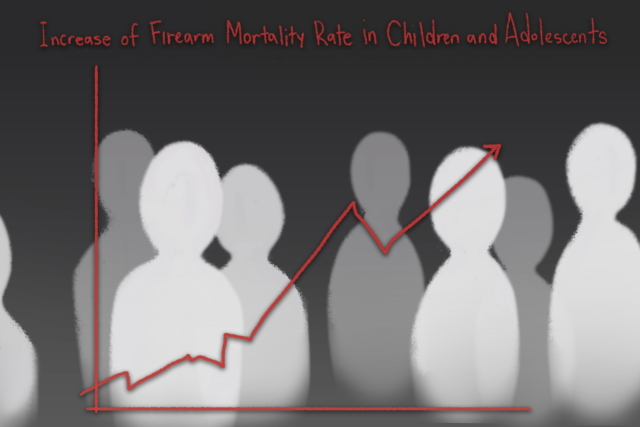[ad_1]
Ninety percent of states saw an increase in child and adolescent firearm mortality rates from 2018 to 2022, according to a University of Michigan study published Sept. 3
In a cross-sectional analysis, researchers from the University’s Institute for Firearm Injury Prevention assessed mortality data from the Centers for Disease Control and Prevention’s Wide-Ranging Outline Data for Epidemiologic Research and found that firearms are the leading cause of death among children and adolescents in 25 states, and among the top two causes of death in 42 states. According to the study, North Dakota saw the largest increase in mortality rates from 2018 to 2022, while Rhode Island experienced the largest decrease during that time.
Eugenio Weigend Vargas, primary author of the study and postdoctoral research fellow at IFIP, said the significant variations in state-to-state mortality rates were likely due to a variety of factors.
“Those states that tend to have the highest mortality rate among children and adolescents also tend to have firearms as the primary cause of death,” Vargas said. “There are socioeconomic factors when you’re talking about firearm-related mortality. There is a whole difference across states in terms of firearm ownership, firearm laws, that could be potentially driving those differences as well.”
Vargas said the study found states with higher per capita mortality rates in children and adolescents usually have firearm injuries as the leading cause of death compared to states with lower per capita mortality rates that did not rank firearms among the top two causes of death.
“There are many states, like Mississippi for example, that have very permissive gun laws, versus states like Massachusetts that have very strict gun laws,” Vargas said. “There’s less access to firearms among youth to perpetrate suicide or be involved in accidents or be involved in homicides.”
Though the study defined children and adolescents as people between one and 19 years old, it found the mortality rate increase was greatest from ages 10-to-19 years old.
Patrick Carter, senior co-author of the study and co-director of the Institute for Firearm Injury Prevention, said that there are a variety of other risk factors for adolescent mortality. However, he emphasized that the researchers did not establish a causal relationship between these factors and the overall increase in mortality.
“(Adolescents are) more impulsive, they’re more likely to be testing the boundaries of behavior and they’re also more likely to experience first time issues like depression and breakups,” Carter said. “New types of behaviors emerge that are pretty normal for teenagers and adolescents, but when you combine it with firearm availability and access, it can be a sort of toxic mix if not addressed in the right way.”
Carter said there is limited research exploring these increases in childhood mortality, and this study represents an advancement in the national conversation about gun violence and public safety.
“It’s just a marker that we need to do more, and we need to think carefully about how we do that in a way that respects the traditions of the Second Amendment, but also reduces the potential for injury and deadly outcomes,” Carter said. “Addressing the issue of firearm injury prevention requires a holistic approach, where we think about interventions that can be done at all levels, from things that we can do individually, to one-on-one.”
LSA senior Kylie Barcino, president of the U-M chapter of March For Our Lives, said she was devastated when she first read the study.
“It’s not exactly surprising,” Barcino said. “In Michigan, in particular, we struggle a lot with young people accidentally harming themselves and intentionally harming themselves with firearms, which is why the governor recently enacted her firearm safety laws and regulations.”
Barcino explained that many people carry the misconception that most gun violence is related to criminal activity, failing to consider that a majority of all firearm deaths are suicides.
“I think we really underemphasize how big mental health is … particularly in the state of Michigan,” Barcino said. “This is a really pressing issue and I think this coming election paying attention to gun safety legislation and politicians that align with those kinds of policies is going to be essential.”
Vargas said he plans to explore how differences in state gun laws and socioeconomic factors further explain the extensive variations in state-to-state mortality rates in children and adolescents.
“Let’s look at those different factors and run some models to see what they indicate,” Vargas said. “Firearm mortality is the main cause of death in the U.S., but it’s also in Brazil, Colombia, Mexico, so it’s a problem in the U.S., but it also appears to be a regional issue.”
Vargas emphasized the urgent need for action at every level due to the alarming rise in child and adolescent mortality rates.
“There’s a trend showing that mortality is increasing across these age groups,” Vargas said. “And that injury-related, particularly firearm and vehicle-related deaths, are driving those increases that not only federal, but state-level policy makers and state-level organizations should take into account.”
Daily News Reporter Barrett Dolata can be reached at bdolata@umich.edu.
Related articles
[ad_2]
Source link











